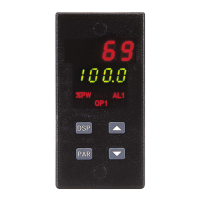Receiving Data
Data is transmitted from the TCU when a “ T” Transmit Value or a “P”
TransmitPrint Options command is sentto the unit via the serial port. Data is
also transmitted when the User Input, programmed for the Print Request
function, is activated. The print rate feature allows the selected print options
to be transmitted ata programmable rateover the serial port. The format fora
typical transmission string with mnemonics is shown in Figure 23, Typical
Transmission String:
The first twod igits transmittedare the unit address. Ifthe unit address is 0,
thef irst twodigits areblank. Aspacefollows theunit addressdigits. Thenext
three characters are the mnemonics followed by one or more blank s paces.
The numerical data value is transmitted next followed by the identifying
units. Negative values are indicated by a “-” sign.
The decimal point position “floats” within the data field depending on the
actual value it represents. The numeric data is right justified without leading
zeros.
When a “T” command or print request is issued, the above character string
is sent for each line of a block transmission. An extra <SP><CR><LF> is
transmitted following the last line of transmission from a print request, to
provide separation between print-outs.
If abbreviated transmission is selected, only numeric data is sent. If
abbreviated transmission is not selected, the unit transmits mnemonics and
the numeric data.
If more than one string is transmitted there is a 100 msec minimum to 200
msec maximum built-in time delay after each transmission string and after
each block of transmission. When interfacing to a printer, sending
mnemonics are usually desirable. Examples of transmissions are shown:
1 TMP 500F<CR><LF>100 - 200 msec Mnemonics Sent
1 SET 525F<CR><LF>100 - 200 msec
1 PWR 20%<SP><CR><LF><SP><CR><LF>100 - 200 msec
-673.5<CR><LF>100 - 200 msec No Mnemonics Sent
The Print Options provide a choice of which TCU data values are to be
transmitted.The TCU transmitsthe Print Optionswhen either the UserInput,
programmed for the print request function is activated, a “P” (Transmit Print
Options) command is sent to the TCU via the serial port, or the Automatic
Print Rate is set f or a specific time. The Print Options are programmed in the
Serial Communications Module (6-SC) with the available options:
1. Print Display Temperature Value.
2. Print Setpoint Value.
3. Print % Output Power Value.
4. Print % Proportional Band Value.
5. Print Integral Time Value.
6. Print Derivative Time Value.
7. Print Alarm 1 Value.
8. Print Alarm 2 Value.
9. Print Deviation From Setpoint Value.
10. Print % Output Power Offset Value.
11. Print Setpoint Ramp Rate Value.
12. Print Cooling Relative Gain Value.
13. Print Cooling Deadband Value.
14. Print Output Status
15. Print Remote Setpoint Ratio
16. Print Remote Setpoint Bias
17. Print Proportional Band #2
18. Print Integral Time #2
19. Print Derivative Time #2
20. Print Second Input Reading
21. Print Remote Setpoint Reading
22. Print Secondary Setpoint Value
23. Print Heater Current Reading
Figure 23, Typical Transmission String

